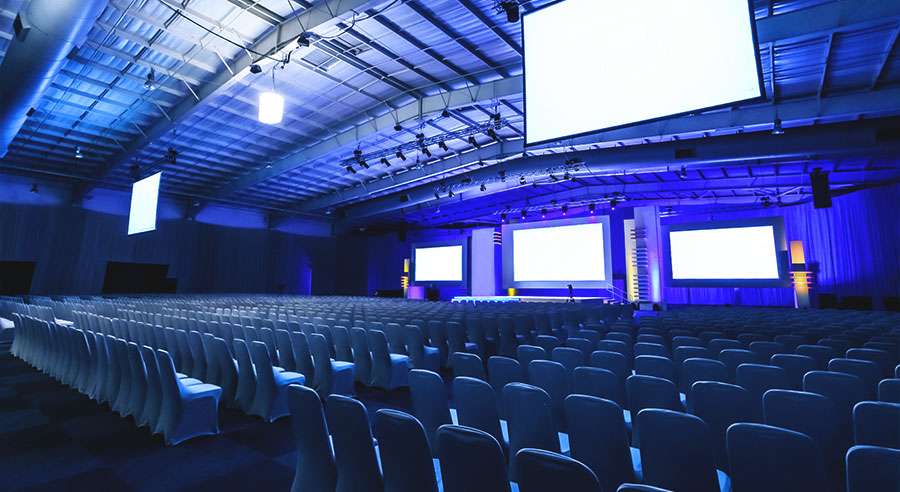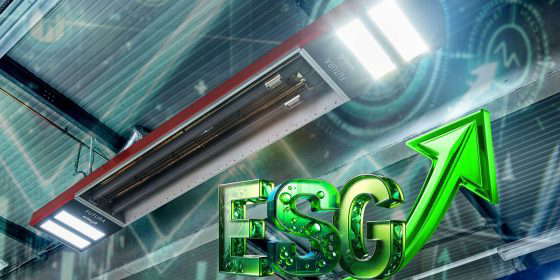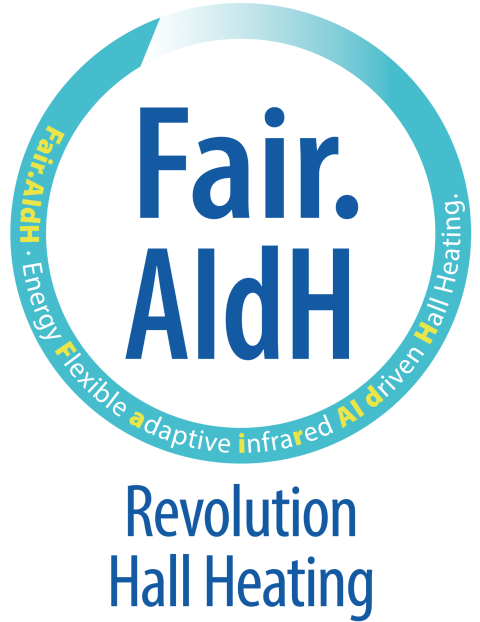Hall heaters - solutions for event halls and exhibition rooms

Concerts, art exhibitions and corporate events are increasingly taking place in unusual locations - for example in old fish factories, heating plants or in tents on historic factory sites. The ambience is often a mixture of rustic and modern. An atmosphere that only unfolds, however, when the temperature is right. After all, who likes to drink Chardonnay with cold feet? Or eat a salmon canapé with a chilled nose?
That's right, nobody. And that's why most event organizers strive to maintain a comfortable temperature. They experiment with various heating solutions. For example, with mobile warm air heaters that blow heated air into tents via warm air hoses. Or with mushroom heaters, near which guests warm themselves with a gas flame.
The problem: many hosts are not really satisfied with warm air systems as hall heaters
Because warm air has a mind of its own. It is distributed unevenly in halls and tents, mixes with cold layers of air and creates a draught on guests' legs, arms and necks. "Darling, do you think we should leave so slowly?" is a sentence that is uttered far too early in the evening at worst. Not the only drawback.
The electricity bill is also often unnecessarily high. This is because warm air escapes towards the ceiling - i.e. to where it does no one any good and only causes energy costs. Creating different temperature zones, such as a cool zone at the buffet and a warmer one in the common areas? Virtually impossible with air that is constantly mixing. Last but not least, many warm air systems do not look very stylish as hall heaters, more like relics from the 1980s. They often cannot be integrated into a modern environment without a visual break. And in the worst case, they are so loud with their humming and hissing that they disturb the ambience.
Targeted and economical heating: infrared heaters reshuffle the cards
For hosts who are not satisfied with warm air systems because they are too loud and unattractive, consume too much energy and do not even satisfy many guests, there is an alternative solution: Infrared heaters. These hall heaters are reshuffling the cards when it comes to heating event halls and exhibition spaces. Why?
Because their functional principle differs fundamentally from that of warm air systems. Infrared systems do not heat the air. Instead, they generate electromagnetic waves that are converted into heat as soon as they hit solid objects - such as guests or tables, benches and stages. The advantage: hosts no longer have to heat the entire air in a hall or a large tent to create a pleasant temperature, but can concentrate specifically on the area of use. As this is usually many times smaller, you save a lot of energy. But that's not all.
Bringing the pleasure of pleasant sunlight indoors
Do you know this? You go for a walk on a fall day. The air is pleasantly cool, but at the same time you can feel the warm rays of the sun on your skin. A feel-good atmosphere that infrared heaters also create indoors. Guests find the infrared heat particularly pleasant because it corresponds to the natural heating principle of the sun - without dry heating air, dust turbulence and draughts.
The eye is not neglected either. Modern infrared heaters can be discreetly integrated into the surroundings or emphasized as a design element in their own right. In addition, the hall heaters are whisper-quiet and would not even disturb Ludwig von Beethoven's 15th string quartet. They are therefore perfect for controlling the temperature of large marquees, event halls and exhibition rooms.
Hamburg fish auction hall pampers guests with infrared heat
Do you know the fish auction hall at the St. Pauli fish market? It is a magnet for night owls and tourists from all over the world. This is because visitors come here every Sunday from dawn to buy fish sandwiches and other delicacies from hundreds of food stalls and food trucks. They enjoy eating and drinking in a cheerful get-together on beer benches in the fish hall - with live music until twelve o'clock at night. An inviting backdrop that is also appreciated by organizers of cinema festivals, theater and reading days and the multi-day light festival. Events with up to 4,200 people regularly take place in the 4,100 m2 hall.
And the temperature in the fish auction hall is always just right. This is because the operators have installed infrared radiant heaters from the OPTIMA painted to match the style of the architecture and suspended from specially designed, invisible wire ropes. The devices heat the 103 meter long and 23 meter wide hall, which is eleven meters high at the dome, with a total output of 700 kW. The heat from the hall heaters is concentrated specifically on the area of use, i.e. the tables, benches, food stands and, of course, the guests themselves.
The thousands of cubic meters of air above this area, on the other hand, are cool without disturbing anyone. Visitors' ears are also spared any annoying noise. KÜBLER supplied the radiant heaters in a super-silent design and also soundproofed the exhaust fans. This reduces the noise effect from industry standard to almost concert level.
Fish auction hall saves 50,000 euros in heating costs per year
However, the operators of the fish auction hall not only benefit from the modern, unobtrusive appearance and quiet operation of the hall heaters. OPTIMA also reduces energy consumption in the fish auction hall - by up to 50 percent compared to conventional systems. Even more energy can be saved with the digital control system R.O.S.S.Y heating systems can be controlled with pinpoint accuracy and preheating times can be reduced to an environmentally friendly minimum depending on the weather periods and seasons.
The bottom line is a saving in heating costs of 50,000 euros per year. And extrapolated over the life cycle, a saving of 19,830 MWh of primary energy. Enough to heat around 700 average households for a year.
Zum Einsatz kommen Infrarotheizungen von KÜBLER übrigens auch im Tresor, im stillgelegten Heizkraftwerk im Berliner Ortsteil Mitte. Auf mittlerweile sechs Ebenen, verbunden durch Treppen und Zwischengeschosse mit zahlreichen Räumen und Nischen, finden sich über 20.000 m² Ausstellungs- und Veranstaltungsfläche für zeitgenössische Musik, Kunst und Kultur. Fläche, die beheizt werden will. Dafür planten die Betreiber zunächst eine Warmluftbeheizung. Doch schnell war klar: Zuviel Energie würde aufgrund der erwarteten Thermik Richtung Dach verloren gehen.
The alternative: 20 black lacquered infrared heaters from the OPTIMA series. However, the radiators are only part of the heating solution. A heat exchanger called O.P.U.S. X. It makes it possible to use the residual heat from the infrared radiators in the system H.Y.B.R.I.D. to heat water, for example. In this way, the operator of the safe recovers up to 15 percent of the energy that was previously lost to the environment.
-
Do you want to get the most out of your new hall heating system, save energy costs and be prepared for the environmental laws of the future? Then it is advisable to consider a few tips before you buy. Find out which ones in this article.
-
The German government's targets are ambitious: by 2045, Germany is to be climate-neutral and dispense with fossil fuels in the generation of heat. A target that is putting pressure on the industry. Numerous innovations are pushing for a switch to renewable energies - such as the Fuel Emissions Trading Act (BEHG), which sets an increasing CO₂ price for fossil fuels in the heat supply sector.
-
ESG stands for Environmental, Social and Corporate Governance and refers to the three key areas of sustainable corporate management: environment, social affairs and corporate governance. But what does this have to do with you and the way you heat your production halls and warehouses?
-
Save energy costs and protect the environment: Dark radiant heaters are among the most efficient heating systems for halls that you can buy. But which infrared system is right for you? We give you an overview.





